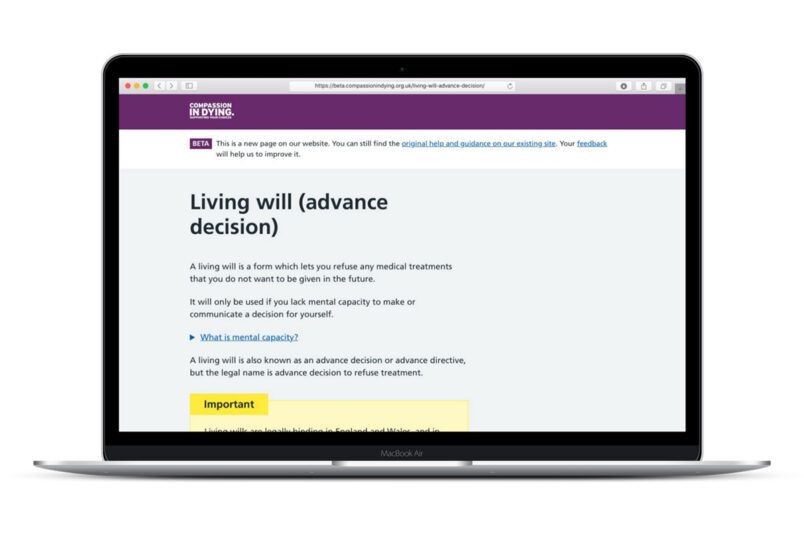People are nearly 9 times more likely to search for ‘living will’ compared to ‘advance decision’.

Our new, user-led content

At Compassion in Dying our work is led by lived experience of what people want and need. We want people to be at the centre of our services, our policy and our information development. To that end, our information and digital teams have collaborated to put user-led content at the heart of what we do.
People repeatedly tell us that the information we provide is invaluable, and the services that support this make a real, positive difference to how people die. But in 2019 we acknowledged that while our website had a wealth of important information, it just wasn’t fit for purpose and there were many things that needed to change.
Our new content (not new website)
Before we even looked at the website, we spent time reviewing how we make content. We spoke to the people we support and our staff, we did a content audit, and we looked at the big picture of what we are trying to achieve.
From this we developed a new content strategy for all our content moving forwards, to give staff a tangible structure to refer to. Our team likes tangible.
We then turned our attention to the website. We started again based on what the most important things were for our users. Beginning with new user research, we spoke with the people we support, and people who might potentially use our services, to understand their needs. These findings alongside desk research enabled us to discover clear user needs.
Our starting point
Through this process we identified four key topics that our target audience was trying to find and use, so we decided to start there:
- Advance Decisions
- Lasting Powers of Attorney for Health and Welfare
- Advance Statements
- DNACPR
Disclaimer: this is where I should mention, we did talk about making a nice shiny new website. In fact, we wanted a nice shiny new website. But working alongside a brilliant digital agency helped us refine our approach, and essentially stopped us throwing the baby out with the bath water.
Usability testing
Working through each key topic individually, we tested and iterated, tested and iterated, tested and iterated until we met our acceptance criteria. This process was sometimes gruelling but has meant we now have user-led and user-tested content which we know works, for now.
Some key insights from the last 24 months
We’ve had to make some pretty big decisions along the way. Some of which could be controversial, such as choosing to focus on the language people actually use over the medical or legally ‘correct’ terminology. But putting the user first means exactly that, and we welcome the opportunity to explain our thinking to anyone who questions those choices. When you commit to following the evidence on what people need, you have to be all in.
1. We’ve learnt to use the language people use (not the language we like)
The best example of this, which I want to address straight away, is our use of ‘living will’.
Those in our world of advance care planning will know that the official term is Advance Decision, or Advance Decision to Refuse Treatment. We know this, it’s been called this since the Mental Capacity Act coined the term in 2005. The problem is, data shows unequivocally that most members of the public don’t use this term, they hardly search for it, and it doesn’t resonate with them.
Not only that, this google trends graph shows this has been consistent for years:

People do use, search for and connect with living will. We’ve spent years at Compassion in Dying putting energy into educating the public and professionals on the official terms for these documents. But the research shows that not only is this a losing battle, it’s focusing energy and attention on the wrong thing. It’s a distraction — to a large degree it doesn’t matter what people call them. What truly matters is people can find what they are looking for, so they can plan ahead in a legally binding way and have the death that’s right for them. That’s what matters. And if using living will in our content is going to make that a reality for more people then that’s what we’ll do.
New terms based on user research
- Advance decision → Living will
- Lasting Power of Attorney for Health and Welfare → Health power of attorney
- DNACPR → DNR (for members of the public, we’ll use DNACPR for professionals)
2. We’ve learnt people like honesty
The other big change is the tone of our content. We’ve been consistently told through our services, and now backed up by our content research, that people want to know what the reality of their situation is.
We want to speak up for people, and champion their voice.
So we’ve moved away from our factual tone, and have brought in learning from years of supporting people through our services, to ground information in reality and give people an idea of what to expect. We’ve used real personal experiences to highlight potential problems and offer helpful tips.
A good example of this is preparing people to share their living will with a GP. Every week we hear about people’s interactions with their GPs when sharing their planning documents. Some are good, many aren’t. So now as well as suggesting people give a copy to their GP so that it can be added to their medical records and found when needed, we’re also preparing people for how this appointment might pan out. We are arming them with the information they need (for example what to do if their GP doesn’t know what a living will is) to be sure their voice is heard.
3. We’ve learnt to ditch the capital letters
As the NHS service manual suggests, our research showed that people understand and retain information better when you do not capitalise words or phrases. It’s that simple. So we’ve dropped the capitals throughout our content, apart for proper nouns.
4. We’ve learnt it’s hard to ‘work out loud’ consistently
One of our aims of this project and more generally was to bring the whole team along with us, and give back to the content community — through blogs like this!
The reality of working in a small charity, with multiple roles and competing commitments means this hasn’t been easy. We’ve learnt that we need to find a way to integrate working out loud and sharing our learning as a core element of the work we do — and we’re still working on this.
This helpful book called the ‘Agile comms Handbook’ came out at the end of last year which may help us with this.
5. We’ve learnt content can’t be rushed
The last 18 months have been dedicated to content design, new user research, pair writing, content crits, prototyping and usability testing.
As everyone who does this works knows, it is hard graft. At times some problems felt impossible to solve, and there were many sprint weeks of usability testing where we felt like we’d taken one step forward, and ten giant steps back. But we had a brilliant team and a clear sense of purpose (thanking our past-selves for that content strategy massively).
It’s also helpful to admit that it’s been a pretty dicey climate for everyone over the last two years, the pandemic threw our workloads and focus off on a number of occasions. And some of the needs of the people that use our services have also changed because of the pandemic. Which meant what was planned for a 6 month project, turned into 24 months of interrupted schedules.
While it took longer than planned, the process was enormously helped by all of the brilliant work the NHS digital team has put into their service manual which has been road tested and made publicly available — many thanks for this generosity!
What we’re launching today
And so today we’re launching five new pages of content:
- Living will (advance decision)
- Health power of attorney
- DNR forms and CPR decisions (for the public)
- DNACPR forms and CPR decisions (for professionals)
- Advance statement
This is very much the first step. We’ll be collecting data from these beta pages and keeping track of how the content is being used, what’s working and what’s not. Allowing us to update the information and develop with our users, because we now know that content is never finished, and we’re starting to like that.
Alongside this work we’ll be moving on to other areas of the website and developing them, and we’ll keep working out loud as much as possible along the way.
If you’d like to talk about any of this work (or yours) then please get in touch — on email or on Twitter.